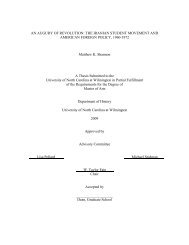Saprolegnia - The iLumina Digital Library
Saprolegnia - The iLumina Digital Library
Saprolegnia - The iLumina Digital Library
Create successful ePaper yourself
Turn your PDF publications into a flip-book with our unique Google optimized e-Paper software.
<strong>Saprolegnia</strong> dioica form pseudodioica Schlösser<br />
Planta 8:537. 1929<br />
<strong>The</strong>re is no formal description of this form, and the name appears merely to<br />
represent Schlösser’s attempt to single out a collection that could not with certainty be<br />
identified with <strong>Saprolegnia</strong> dioica de Bary (itself synonymous with S. diclina).<br />
<strong>Saprolegnia</strong> dioica-racemosa De-La-Rue<br />
Bjull. Moskovsk. Obshch. Isp. Prir., Otd. Biol. 42:469. 1869<br />
This name -- it was not written as the variety racemosa of <strong>Saprolegnia</strong> dioica as has<br />
been thought (Seymour, 1970:30) -- was applied to a specimen described only as being<br />
much branched. <strong>The</strong>re are no illustrations, and the description is far too brief to allow<br />
any judgment as to the correct identification. Furthermore, it cannot be listed as a<br />
synonymous species (A. Fischer, 1892; Seymour, 1970) for the same reason.<br />
<strong>Saprolegnia</strong> divisa Pringsheim<br />
Phycomyceteae, Berlese and De Toni, in P. A. Saccardo, Sylloge<br />
fungorum onnium hucusque cognitorum. Vol. 7, p. 269. 1888<br />
This name is an orthographic error committed by Berlese and De Toni (loc. cit.),<br />
presumably in transcribing <strong>Saprolegnia</strong> dioica Pringsheim.<br />
<strong>Saprolegnia</strong> elongata Massee<br />
British Fungi, p. 271. 1891<br />
As Coker (1923:76) pointed out, Massee’s species was based in part on a<br />
Pythium and in part on a <strong>Saprolegnia</strong>. Goldie-Smith (1952:287n) thought the Pythium<br />
component might have been P. undulatum Petersen. <strong>The</strong> other component is not<br />
identifiable.<br />
<strong>Saprolegnia</strong> exigua Murgoci<br />
Bull. Acad. Roumâna, Bucharest Seçt. Stünifica 30:158 et sqq., figs. 5-11. 1947<br />
Without a doubt, Murgoci observed a fungus in the notocord and cartilaginous<br />
portions of the vertebra (and in adjacent musculature and connective tissue) of sterlet<br />
from Rumania, but its identity is obscure. She reported that secondary sporangia were<br />
formed in empty ones, and illustrated the spores as biflagellate cells. However, she<br />
gave the dimensions of the oospores as 3.5-4.8 µm in diameter. <strong>The</strong> description is<br />
inadequate, and, moreover, unaccompanied by a Latin diagnosis. <strong>The</strong>se are sufficient<br />
grounds on which to exclude the species.<br />
654
















